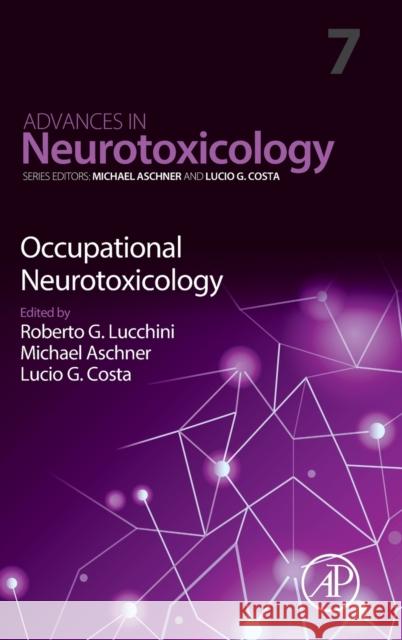Occupational Neurotoxicology: Volume 7 » książka



Occupational Neurotoxicology: Volume 7
ISBN-13: 9780128191767 / Angielski / Twarda / 2022
Occupational Neurotoxicology: Volume 7
ISBN-13: 9780128191767 / Angielski / Twarda / 2022
(netto: 695,40 VAT: 5%)
Najniższa cena z 30 dni: 724,19
ok. 30 dni roboczych.
Darmowa dostawa!
Preface Roberto G. Lucchini 1. Current evolution of neurobehavioral methods Maryse F. Bouchard, Diane S. Rohlman, Carola Tuerk, Hana-May Eadeh, Trisha Saha and W. Kent Anger 2. Cognitive impact of exposure to airborne particles captured by brain imaging Somaiyeh Azmoun, Jenny Diaz, Cheuk Y. Tang, Megan Horton, Sean A.P. Clouston, Ben J. Luft, Evelyn J. Bromet, Sam Gandy, Donatella Placidi, Claudia Ambrosi, Lorella Mascaro, Carlo Rodella, Barbara Paghera, Roberto Gasparotti, Jeremy W. Chambers, Kim Tieu and Roberto G. Lucchini 3. Clinical evaluation and differential diagnosis of neurotoxic disease Jonathan Rutchik and Marcia H. Ratner 4. Aerotoxic syndrome: A new occupational disease caused by contaminated cabin air? G. Hageman, SJ Mackenzie Ross, J. Nihom and G. van der Laan 5. Occupational neurotoxicity of organic solvents Christoph van Thriel and William K. Boyes 6. Pesticides Diane S. Rohlman, James R. Olson, Ahmed Ismail, Matthew R. Bonner, Gaafar Abdel Rasoul and Olfat Hendy 7. Diagnosis and management of occupational and environmental carbon monoxide neurotoxicity Jonathan Rutchik and Marcia H. Ratner 8. Mercury neurotoxicity in gold miners Maria Elena Crespo-Lopez, Marcus Augusto-Oliveira, Amanda Lopes-Araújo, Letícia Santos-Sacramento, José Rogério Souza-Monteiro, Felipe Farias da Rocha and Gabriela de Paula Arrifano
Dr. Aschner serves as the Harold and Muriel Block Chair in Molecular Pharmacology at Albert Einstein College of Medicine. He served on numerous toxicology panels (Institute of Medicine, US Environmental Protection Agency, Center for Disease Control), and is a member of the Neurotoxicology and Alcohol study section (NIH). Research in our lab focuses on the following topics: (1) Modulation of C. elegans genes (aat, skn-1, daf-16) that are homologous to mammalian regulators of MeHg uptake and cellular resistance will modify dopaminergic neurodegeneration in response to MeHg exposure. (2) Under conditions of MeHg-induced oxidative stress, Nrf2 (a master regulator of antioxidant responses) coordinates the upregulation of cytoprotective genes that combat MeHg-induced oxidative injury, and that genetic and biochemical changes that negatively impact upon Nrf2 function increase MeHg's neurotoxicity. (3) PARK2, a strong PD genetic risk factor, alters neuronal vulnerability to modifiers of cellular Mn status, particularly at the level of mitochondrial dysfunction and oxidative stress. Our studies are designed to (1) shed novel mechanistic insight into metal-induced neurodegeneration; (2) identify targets for genetic or pharmacologic modulation of neurodegenerative disorders; (3) increase knowledge of the pathway involved in oxidative stress; (4) develop improved research models for human disease using knowledge of environmental sciences.
Dr. Lucio G. Costa is Professor of Toxicology at the University of Washington in Seattle, and of Pharmacology/Toxicology at the University of Parma Medical School. He received a doctorate in Pharmacology from the University of Milano in 1977, and was a postdoctoral fellow at the University of Texas at Houston. He is a member of several national and international professional organizations, a Fellow of the Academy of Toxicological Sciences, and a European Certified Toxicologist. He received various award for his scientific accomplishments, including the Achievement Award from the Society of Toxicology. He serves in various editorial capacities for several toxicology journals, and is an active manuscript and grant reviewer. Dr. Costa has been the member of dozens of panels and committees at the national and international level dealing with toxicology and risk assessment issues. He has chaired and/or organized symposia at scientific meetings in the United States and internationally. He has been teaching classes in the area of toxicology, neurotoxicology and pharmacology to graduate and medical students for 30 years. He keeps an active research program in the area of neurotoxicology.
Medicine at Mount Sinai, New York. He was also the Director of the World Trade Center Data Center at Mount Sinai and the Director of the NIOSH funded Education and Research Center for the States of New York and New Jersey. In these capacities, he coordinated the epidemiological health surveillance of the workers involved in the clean-up operations after 9/11. Dr. Lucchini was also director of the Selikoff Centers of Occupational Health, the largest center of Occupational Medicine in the USA. Since 2020, Dr Lucchini is a Professor at the School of Public Health, Florida International University, where he continues his research interests with further developments in a highly qualified scientific environment. He has also conducted studies on the risk factors for covid-19 disease severity and mortality, including occupational and environmental exposure to airborne particulates and air pollution.
Dr. Lucchini's research is focused on the health effects of neurotoxic chemicals and the biological mechanisms by which metals, pesticides, persistent organic pollutants, particulate matter and other toxic chemicals can cause injury in the human nervous system, from neurodevelopment to neurodegeneration. He and his team have conducted studies in general populations as well as in occupational groups. With support from Italian National funds, the EU and NIEHS, they have assessed the effects of neurotoxic chemicals across the life span in populations that range in age from early childhood, through adult life to old age. They have also undertaken studies in patients with neurodegenerative diseases and the role of occupational and environmental determinants in aging. These studies are focused in the highly industrialized provinces of Brescia and Taranto and target the exposure to neurotoxic metals including manganese. More recently Dr. Lucchini became involved with the research on the health effect among workers and responders who were exposed to chemicals and intense psychological trauma at the World Trade Center after the 9/11 terroristic attack. He is studying the increased frequency of neurological conditions through the use of fMRI and PET imaging techniques.
1997-2026 DolnySlask.com Agencja Internetowa
KrainaKsiazek.PL - Księgarnia Internetowa









